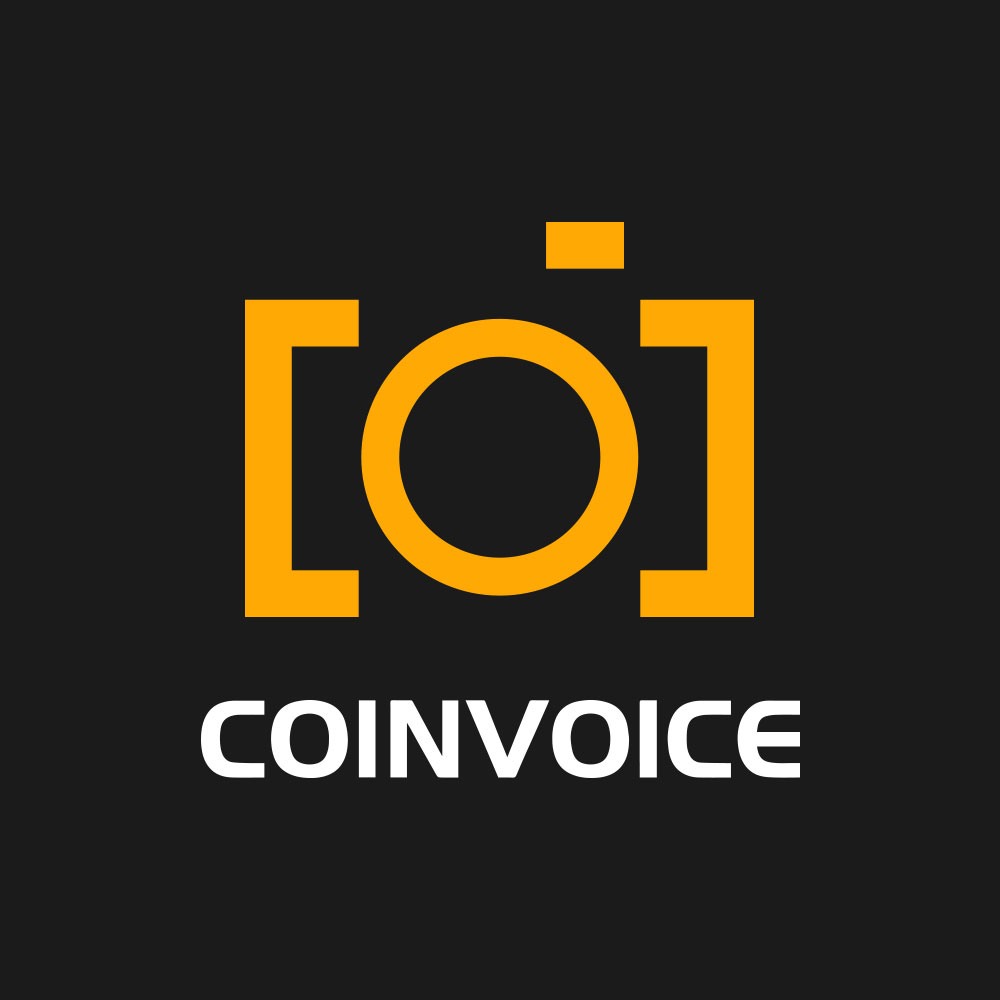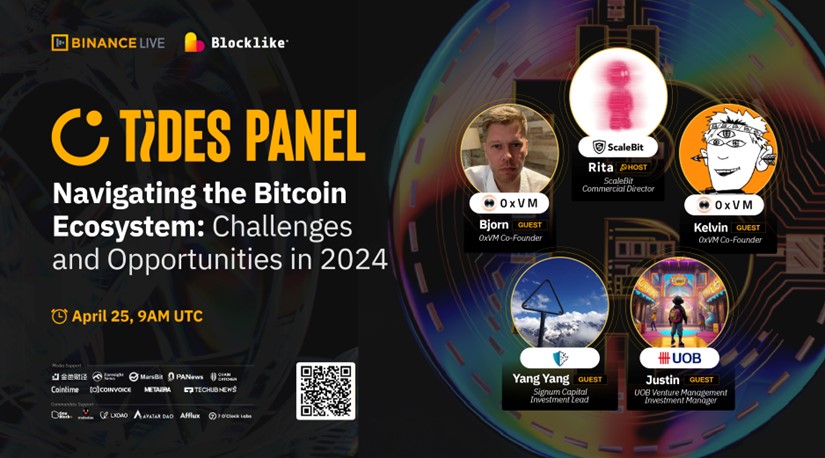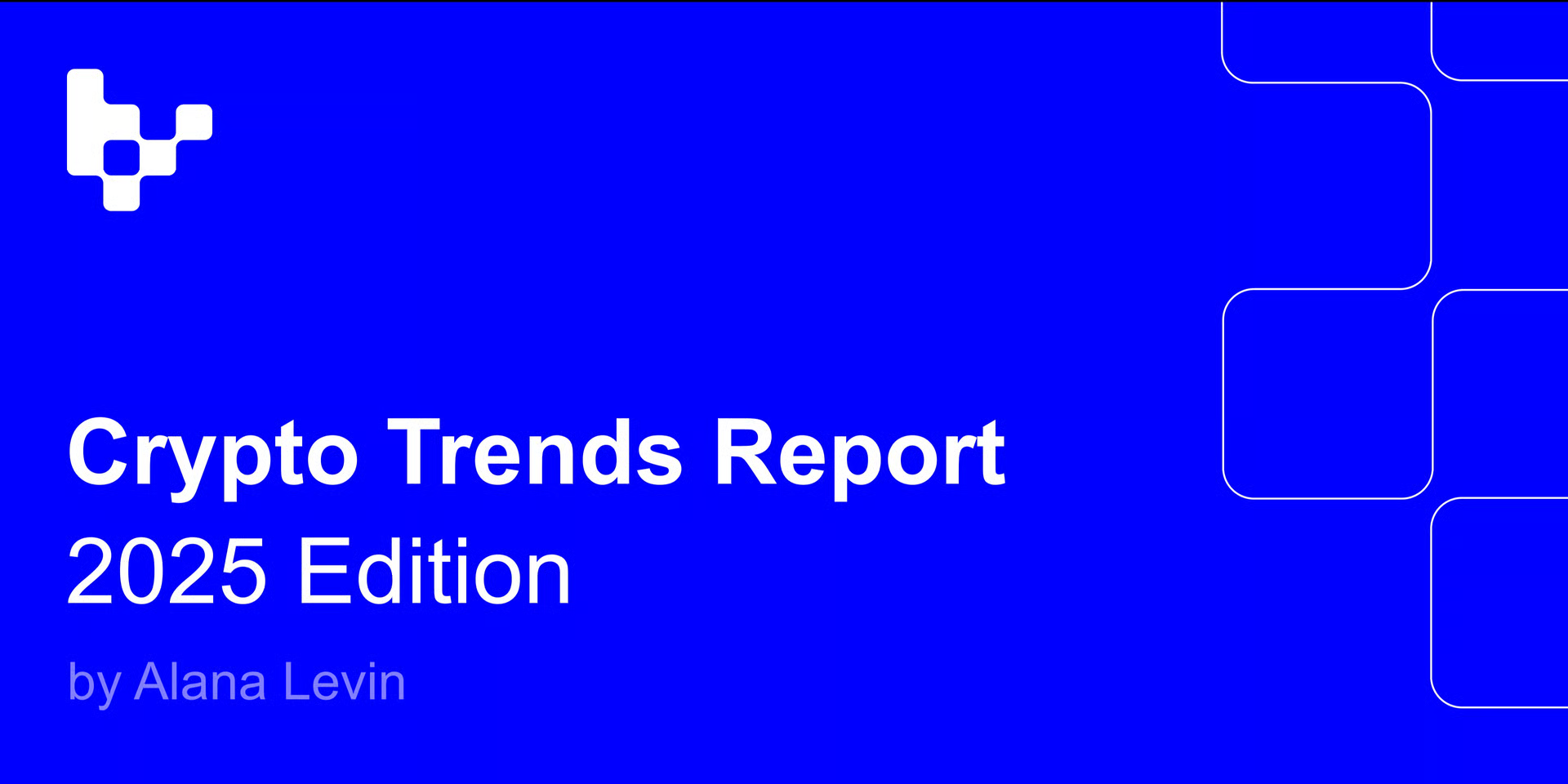On April 25, Blocklike held a panel discussion on the theme of "Navigating the Bitcoin Ecosystem: Challenges and Opportunities in 2024" on Binance Live. The event was hosted by Rita, Commercial Director of ScaleBit, and invited Bjorn and Kelvin, the two co-founders of 0xVM, the modular execution layer of the Bitcoin ecosystem, as well as representatives of institutions deeply involved in the Bitcoin ecosystem: Yang Yang, investment director of Signum Capital, and Justin, Investment Manager at UOB Venture Management.
With the rise of the Bitcoin ecosystem, more and more innovative projects and technologies are emerging in this ecosystem, making the Bitcoin ecosystem gradually become one of the focuses of the crypto world. The guests at this panel jointly discussed innovative technologies, applications, and practical implementations in the Bitcoin ecosystem, and shared their thoughts on Bitcoin inscriptions, layer 2 solutions, NFT, DeFi, cross-chain technology, and other fields. Below are some highlights shared by the guests.
Overview of Bitcoin Ecological Development
The guests believed that the positioning of Bitcoin is gradually changing from a “store of value role” that is generally believed to be a “basic technology platform for building a trust-consuming financial system”. With Bitcoin hitting all-time high, many projects have developed and built new products in this ecosystem. From Bitcoin-based technologies such as UTXO, SegWit, and Taproot upgrades to current protocols such as Ordinals and Atomics, the underlying infrastructure has been built for the issuance of NFTs, Tokens, and other assets in the Bitcoin ecosystem.
However, due to the dilemma of Bitcoin's scalability and transaction confirmation time, if the ecosystem is to develop in the long term, expansion is a problem that all developers in the Bitcoin ecosystem need to face head-on. In terms of improving the scalability of Bitcoin, there are currently two main development routes. One is on-chain expansion, which is optimized on Bitcoin Layer1; the other is off-chain expansion, which is commonly understood as Layer2. Besides the asset issuance protocols and expansion plans, more projects are beginning to show up in the infrastructure field, such as wallets that support inscriptions, decentralized indexers, cross-chain bridges, launchpads, etc.
What makes the Bitcoin ecosystem unique
Regarding the view that "the Bitcoin Ecosystem is merely a replica of the Ethereum Ecosystem", the guests believed that even though there are similarities between the Bitcoin and Ethereum ecosystems, there are more fundamental differences.
From the perspective of initial design goals and core functionality of these two ecosystems, Bitcoin was designed first and foremost as a decentralized digital currency whose primary purpose is to serve as a means of payment and store of value. While the Ethereum is designed as a smart contract platform to expand the application scope of blockchain and support the development and operation of decentralized applications. This fundamental design difference determines the development direction and technical focus of the two ecosystems.
From the perspective of technological development, Bitcoin's blockchain technology pays more attention to security and stability, which is reflected in the conservative nature of its network operations and its consensus algorithm that values long-term. In contrast, Ethereum focuses more on flexibility and scalability, especially in the implementation of smart contracts and decentralized applications. The robustness of the Bitcoin ecosystem has allowed it to be viewed globally as digital gold, rather than just as a payment method or application platform.
In addition, Bitcoin, as the first successful blockchain project, has a deep technical foundation and a group of loyal supporters and developers. This unique community culture and philosophy has shaped the development direction of the Bitcoin ecosystem, making it unique among many blockchain projects.
EVM or UTXO?
From a technical perspective, the guests believed that the EVM faction and the UTXO faction represent two different technical paths and design philosophies in the Bitcoin ecosystem. EVM faction focuses on providing smart contract functions compatible with Ethereum, which can attract more developers and enterprises to use the Bitcoin platform to create complex applications. The UTXO faction insists on the original simplicity and security of Bitcoin, and its method may be more suitable for users who value transaction reliability and network security.
The existence of the EVM faction and the UTXO faction also reflects the different views and needs of the Bitcoin community on the future development direction. The EVM faction aims to solve the limitations of Bitcoin in smart contracts and advanced applications, while the UTXO faction is more focused on optimizing and maintaining Bitcoin as a safe and reliable means of payment and value storage.
The co-existence of these two factions is not only possible but critical to the long-term development of the Bitcoin ecosystem. Their different advantages may find their way into different markets and applications, enriching and strengthening Bitcoin’s market position. While there may be some friction and competition in the short term, this diversification may be the Bitcoin ecosystem’s greatest asset in the long term.
Bitcoin Layer 2 and 0xVM
Guests believed that the Bitcoin Layer 2 ecosystem is booming, and there are three main routes for the second-layer construction of Bitcoin: One is the chain-based expansion route, which is similar to Ethereum's EVM and adopts a blockchain structure. The second is based on distributed route, represented by the Lightning Network, using a distributed structure. The third is based on the route of a centralized system, represented by a centralized index, adopting a centralized structure. Each of these methods has its characteristics, and some products are already in practical application or under exploration.
0xVM is one of the Bitcoin layer-2 solutions. Kelvin mentioned that 0xVM, as the execution layer for Bitcoin, leverages Bitcoin as a robust data availability layer, inheriting its strong security consensus. Unlike other Layer-2 solutions, 0xVM does not require asset lockup or complex payment channels, ensuring assets remain fully secured on the Bitcoin network.
0xVM has several key features:
(1) Security
By leveraging Bitcoin as the data availability layer, all the 0xVM transactions are Bitcoin transactions. Asset consensus and security are directly inherited from the Bitcoin network. There is no need for cross-chain bridges or channels, eliminating the risks of contract vulnerabilities, and reducing complexity and risk.
(2) Scalability
Innovative batch instructions, instruction encoding optimization, and parallel execution mechanisms enable high execution speeds. EVM compatibility brings programmability and computation capabilities, delivering Solidity-equivalent programmability without relying on centralized rollup structures, introducing a dApp ecosystem to the Bitcoin network. Assists BTC L2 applications in directly validating data on the Bitcoin blockchain, enhancing interoperability and providing a foundation for composability.
(3) Cost-Efficient
The hybrid on-chain verification and off-chain computation architecture, powered by the Indexer component, dramatically reduces the computational and storage burden on the Bitcoin network, enabling significantly lower transaction fees for large-scale applications
How 0xVM takes advantage of modularity
As an EVM-compatible execution layer for Bitcoin, 0xVM empowers the network with Turing-complete smart contract functionality, unlocking a broader range of dApps within the Bitcoin ecosystem. It uses Bitcoin as a robust data availability layer to retrieve transaction contents on the Bitcoin chain that conform to the 0xVM protocol specification to obtain instructions, and executes them on the 0xVM, with 0xVM nodes verifying the output results.
Through innovative batch instructions, instruction encoding optimization, and parallel execution mechanisms, it delivers high-performance scaling for the Bitcoin network. In addition, 0xVM serves as a trustless verification layer that is for BTC L2 solutions to directly validate data on the Bitcoin blockchain. It enables Bitcoin to truly scale out through diverse L2 solutions and support interoperability between various L2 platforms.
The future development of the Bitcoin ecosystem
The guests expressed their expectations for the development of the Bitcoin ecosystem. They think It is foreseeable that the Bitcoin ecosystem will have more innovative projects and diverse application scenarios. From NFT to DeFi to Layer 2 solutions, the Bitcoin ecosystem is constantly expanding and enriching, providing users with more choices and services.
In the future, with the continuous development of technology and the continuous expansion of application scenarios, they believe that the Bitcoin ecosystem will usher in a more prosperous development situation. Bitcoin will continue to play the role of digital gold and will also become the basic technology platform for building a more open, secure, and efficient financial system.
Special thanks to the following media for their support of the event: JinseFinance、ForesightNews、MarsBit、PANews、ChainCatcher、Cointime、COINVOICE、MetaEra、TechubNews.















